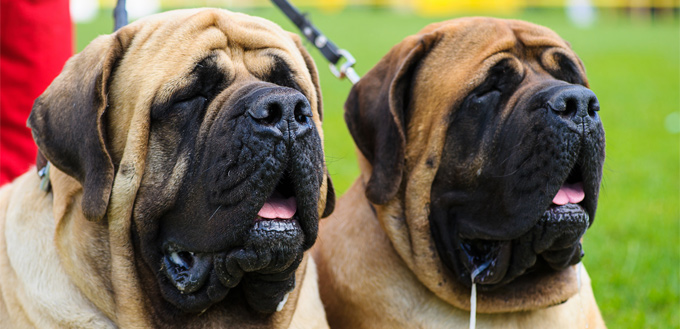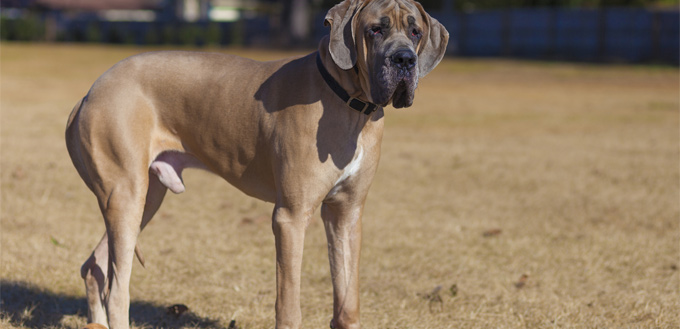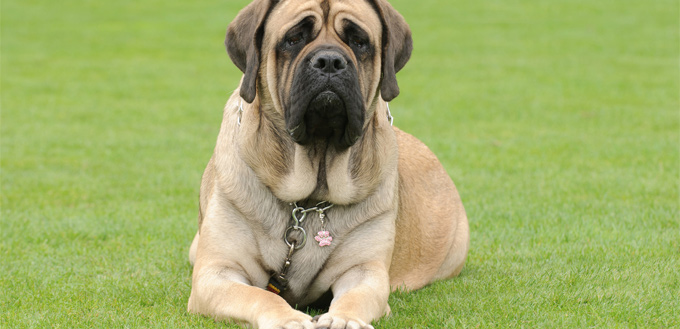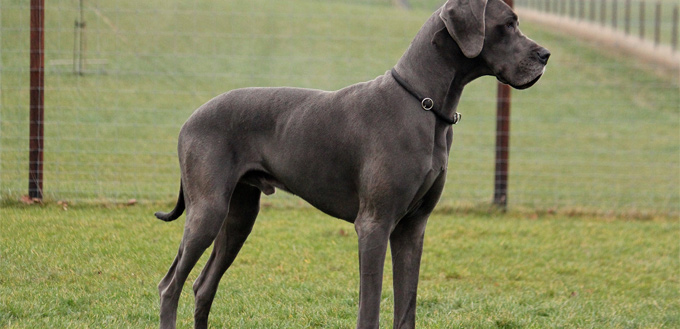Imagine crossbreeding two of the dog world’s largest breeds and you’d definitely get an equally gigantic hybrid. With one parent known for its gentleness, devotion, confidence, and friendliness and the other parent revered for its courage, affectionate and calm demeanor, and dignified stance, you are bound to get a crossbreed that is likewise gentle, loving, loyal, and protective of its human family. With a size to boot, the Daniff takes pride in the venerable characteristics of its parents – the Great Dane and the Mastiff. While you may not be able to register this dog with any kennel club in the world, you can always register the Daniff in your heart.

History of the Daniff
The Great Dane Mastiff Mix is a crossbreed and like all products of modern crossbreeding, it really is quite difficult to ascertain its history. However, both the Great Dane and the Mastiff are known to be very ancient dogs. This should give you an idea that the Daniff might not really be entirely new. While you won’t see the Daniff in the registry of the American Kennel Club or any other official kennel organization under the Federation Cynologique Internationale or the World Canine Organization, you can nevertheless see it registered with the International Designer Canine Registry. As of 2009, the international organization of crossbred or hybrid dogs has officially recognized the Daniff as a designer dog.
For the IDCR to recognize a certain mix breed as a designer dog, it should have already displayed some discernible characteristics that can only be achieved over time. Historically, it would take about 20 to 30 years before a breed is recognized by the FCI which has stricter rules. On the other hand, the rules governing designer dogs are still somewhat arbitrary, allowing for the recognition and registration of such designer dogs on a much faster pace. As such, if a purebred can get recognized in 2 to 3 decades, a designer dog can have the recognition from IDCR within 10 to 15 years. In that case, crossbreeding the Great Dane with a Mastiff may have started in the last decade of the 20th century.
Who are the Parents?
The key to understanding the Daniff is in one’s clear appreciation of the lineage of its parents, the Great Dane and the Mastiff. This is very important since the Daniff will obtain 50% each of its characteristics from both parents.
Great Dane
Scooby Doo may be known for his goofy antics, but the Great Dane is anything but. Very devoted, friendly, and loving, the Great Dane is one giant lap dog. Despite its size, the Great Dane loves nothing more than cuddle up with you while watching TV all day. It’s one of the largest dogs that would fit right in a small apartment for the mere fact that it doesn’t really need that much exercise.

Contrary to what you might think, the Great Dane is of German origin, not Denmark. This giant breed owes its existence and characteristics to a few giant dogs like the Irish Wolfhound, the Mastiff, and the Greyhound. These are what give the Great Dane its characteristic height, heft, and sleek physique, respectively. However, the breed’s origins can actually be traced as far back as the Tiryns of ancient Greece in the 14th to 13th century BC. They were known as the boarhounds. In the mid-16th century, a crossbreed between the Irish wolfhound and the English mastiff resulted in the Great Dane.
The breed was originally bred for hunting boar, deer, and bear because of its massive size. The Great Dane was a catch dog, used in the hunt to hold down prey until the hunter is able to kill it.
The Great Dane has a very regal appearance, elegant, and dignified. It can reach up to 190 pounds and about 32 inches at the shoulder, although it’s not unusual for some dogs to grow bigger.
One of the most common health problems of a Great Dane is gastric dilatation volvulus which almost always starts with bloat. They are also prone to cardiomyopathy, hip dysplasia, hypertrophic osteodystrophy, and cancer.
You May Also Like: Dog Food For Great Danes
Mastiff
The English Mastiff is one giant dog, often growing up to 250 pounds for the male and about 180 pounds for the female. It may be shorter than the Great Dane, but it sure comes with a beefier, well-muscled appearance. It has a massive head complete with the now-characteristic black mask. The Mastiff has a relatively short coat.
It is strongly believed that the Mastiff is a descendant of the great ancient dogs of Central Asia. For thousands of years, the Mastiffs were used for hunting, fighting, and guarding. As a matter of fact, the breed is known to be the preferred security by traveling traders and nomads especially those coming from Northern India or Tibet. It is during these travels that the breed was introduced to other parts of the world such as the Middle East, Russia, China, and the Mediterranean. Archeologists have found Egyptian relics that depicted dogs of massive size. Scholars also talk of the Mastiff-like features of the 3-headed dog that guards the underworld in Greek mythology. The Romans, Greeks, and other civilizations were also known to use the Mastiff as battle dogs.
Over the years the breed was slowly developed into gentler dogs, distanced from their fearsome reputation as dogs of war. Throughout the 19th century, the breed underwent transformation from being a war dog to a canine that is valued for its gentleness and unquestionable love and affection for its family. Today, its sheer size alone is all that is needed to deter troublemakers.

The Mastiff has a very gentle and peaceful nature. However, if its family is in danger or is threatened the Mastiff will never hesitate to defend and protect just as it always had in the past.
Like all giant dogs, the Mastiff is prone to hip dysplasia as well as pulmonic stenosis, cardiomyopathy, subaortic stenosis, mitral dysplasia, and a host of other heart problems in dogs.
You May Also Like: Dog Food for Mastiffs
Quick Facts
It is quite easy to imagine how the offspring of two of the world’s largest breeds of dogs would look. In case you cannot paint a picture in your mind, here are some interesting facts about the Daniff:
- Both parents can grow more than 30 inches at the shoulder. As such, you can expect the Daniff to grow anywhere between 30 inches to 34 inches.
- The Mastiff is heavier than the Great Dane, but both actually weigh more than 150 pounds. Surprisingly, the International Designer Canine Registry puts the average weight to be between 115 and 130 pounds, although there have been dogs reaching up to 195 pounds and even 210 pounds.
- With proper care and good nutrition, the Daniff can actually live up to about a decade or so. Unfortunately, like all giant breeds Daniffs don’t actually live that long with the shortest at about 5 or 6 years.
- The Daniff has a smooth, short coat that will not require that much grooming or even brushing.
- If you get an ideal 50-50 split between a Great Dane and a Mastiff, then you’ll get a Daniff that has a body built that’s just right – not too lanky and not too bulky.
Things You Should Know
Before you bring a Daniff to your home, you may want to check out the following things first:
- Training
Both the Mastiff and the Great Dane can be quite stubborn to train. As such, it is also expected that the Daniff can be trickier than other breeds to train. One way you can ensure that your Daniff will respond to your commands is by training it early on. If this is an impossible task or if you are not confident in your skills in basic dog training, then getting the services of a professional dog trainer should do the trick. Among dogs, both the Great Dane and Mastiff are considered to have average intelligence which can add to the challenge of training, although we’ve seen some literature saying they are actually intelligent. Regardless, early training is a must.
- Feeding
The Daniff is a large dog that is very prone to bloat. You can help prevent bloat in dogs by providing your Daniff with smaller yet more frequent feedings. The usual recommendation is to feed dogs twice a day. For the Daniff, feeding 3 to 4 times a day is often better. The meals should be spaced evenly and the total amount of calories and nutrients should be commensurate to the needs of your Daniff.
- Exercise
Both the Great Dane and the Mastiff have below-average exercise needs. All they will ever require from you is about 30 minutes of walking every day and they should be okay. The same can be said of the Daniff. However, it is often better to start them off on twice-daily walking sessions of at least 30 minutes per session and to mix this with mental exercises. In the past their parents may have been prized as a hunter’s best friend. Today, they’re more giant lapdogs. Exercise is still a must, nonetheless.
- Socialization
Like training, socialization should begin early in puppyhood. If you’re going to get a Daniff puppy, make sure that it is not younger than 3 months old. This is to make sure that it has bonded well with its littermates and learned some of the essential things that puppies can only learn from their mommies and littermates. You can also have them enlisted in a kindergarten puppy class so they will learn the dynamics of dog-dog interaction.
- Grooming
Having short coat is definitely an advantage for the Daniff. It doesn’t shed that much as well. Brushing its coat about twice a week or at least once a week is often enough. Bathing is also on an as-needed basis. A big plus is that the Daniff doesn’t drool as much as its parents.
You May Also Like: Brushes for Short Hair Dogs
- Health
Hip dysplasia and heart problems are just two of the most common problems of a Daniff. Bloating and its associated complication are also possible, although there is this perception that crossbreeds are generally sturdier than their parents.
The Daniff is perfect for the following folks:
- Those who like a giant lap dog that doesn’t really require strenuous exercises
- Individuals who don’t like brushing and grooming their pets on a regular basis
- Folks who have kids who are at least 8 years old
- Persons who like a watch dog that can also double as a guard dog, but not as an attack dog
If you have any of the following, a Daniff may not be for you:
- People who dislike having to train and socialize puppies
- Individuals who don’t like being slobbered by their pets

Temperament
The Daniff is the offspring of two gentle giants. It is but natural that it also draws its gentle demeanor and affectionate nature from its parents. It is playful and energetic, too. It is especially affectionate to children, although we wouldn’t really recommend it to families with very young kids. The sheer size of the Daniff alone can easily crush a young child. Close supervision is always a must whenever letting kids interact with dogs. It is exceptionally friendly to other pets, too.
The crossbreed’s loyalty and dedication to its family is unquestionable. It will defend and protect its family no matter what. It doesn’t bark unless it senses something is definitely off. It is the quintessential watch dog; the very same trait that its parents were bred for in ancient times. There is nothing more meaningful for a Great Dane Mastiff Mix than to warn its family of the presence of strangers. And its size alone is enough to scare away folks with bad intentions.
The Daniff is the product of crossbreeding two of the planet’s largest breeds of dogs. It’s a gentle giant, just like its parents. However, it also inherits the unique characteristics of both the Great Dane and the Mastiff, although there’s no way of telling which will be more dominant. Regardless, if it’s a family dog you need, the Daniff more than fits the bill.
Related Post: Great Dane Puppies for Sale
Sources:
- Patty Oelze, Neo Daniff, Wag
- Great Dane, Vetstreet








My Puppy is on its way. Thank you for these info♡